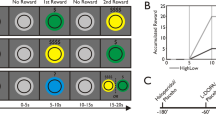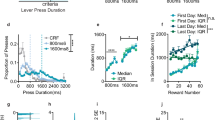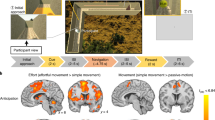Abstract
Decision making requires an actor to not only steer behavior toward specific goals but also determine the optimal vigor of performance. Current research and models have largely focused on the former problem of how actions are directed while overlooking the latter problem of how they are energized. Here we designed a self-paced decision-making paradigm, which showed that rats' performance vigor globally fluctuates with the net value of their options, suggesting that they maintain long-term estimates of the value of their current state. Lesions of the dorsomedial striatum (DMS) and, to a lesser degree, in the ventral striatum impaired such state-dependent modulation of vigor, rendering vigor to depend more exclusively on the outcomes of immediately preceding trials. The lesions, however, spared choice biases. Neuronal recordings showed that the DMS is enriched in net value–coding neurons. In sum, the DMS encodes one's net expected return, which drives the general motivation to perform.
This is a preview of subscription content, access via your institution
Access options
Subscribe to this journal
Receive 12 print issues and online access
$209.00 per year
only $17.42 per issue
Buy this article
- Purchase on Springer Link
- Instant access to full article PDF
Prices may be subject to local taxes which are calculated during checkout








Similar content being viewed by others
References
Kable, J.W. & Glimcher, P.W. The neurobiology of decision: consensus and controversy. Neuron 63, 733–745 (2009).
Lee, D., Seo, H. & Jung, M.W. Neural basis of reinforcement learning and decision making. Annu. Rev. Neurosci. 35, 287–308 (2012).
Niv, Y., Joel, D. & Dayan, P. A normative perspective on motivation. Trends Cogn. Sci. 10, 375–381 (2006).
Niv, Y., Daw, N.D., Joel, D. & Dayan, P. Tonic dopamine: opportunity costs and the control of response vigor. Psychopharmacology (Berl.) 191, 507–520 (2007).
Guitart-Masip, M., Beierholm, U.R., Dolan, R., Duzel, E. & Dayan, P. Vigor in the face of fluctuating rates of reward: an experimental examination. J. Cogn. Neurosci. 23, 3933–3938 (2011).
Hebb, D.O. Drives and the C.N.S. (conceptual nervous system). Psychol. Rev. 62, 243–254 (1955).
Hull, C.L. Principles of Behavior: An Introduction to Behavior Theory (D. Appleton-Century Company, Inc., Oxford, England, 1943).
Ferster, C.B. & Skinner, B.F. Schedules of Reinforcement (D. Appleton-Century Company, Inc., Oxford, England, 1957).
Nakamura, K. & Hikosaka, O. Role of dopamine in the primate caudate nucleus in reward modulation of saccades. J. Neurosci. 26, 5360–5369 (2006).
Ding, L. & Gold, J.I. Separate, causal roles of the caudate in saccadic choice and execution in a perceptual decision task. Neuron 75, 865–874 (2012).
Roesch, M.R. & Olson, C.R. Neuronal activity related to reward value and motivation in primate frontal cortex. Science 304, 307–310 (2004).
Gurney, K., Prescott, T.J. & Redgrave, P. A computational model of action selection in the basal ganglia. I. A new functional anatomy. Biol. Cybern. 84, 401–410 (2001).
Hikosaka, O., Nakamura, K. & Nakahara, H. Basal ganglia orient eyes to reward. J. Neurophysiol. 95, 567–584 (2006).
Turner, R.S. & Desmurget, M. Basal ganglia contributions to motor control: a vigorous tutor. Curr. Opin. Neurobiol. 20, 704–716 (2010).
Lau, B. & Glimcher, P.W. Value representations in the primate striatum during matching behavior. Neuron 58, 451–463 (2008).
Samejima, K., Ueda, Y., Doya, K. & Kimura, M. Representation of action-specific reward values in the striatum. Science 310, 1337–1340 (2005).
Cai, X., Kim, S. & Lee, D. Heterogeneous coding of temporally discounted values in the dorsal and ventral striatum during intertemporal choice. Neuron 69, 170–182 (2011).
Kelley, A.E. Ventral striatal control of appetitive motivation: role in ingestive behavior and reward-related learning. Neurosci. Biobehav. Rev. 27, 765–776 (2004).
Mogenson, G.J., Jones, D.L. & Yim, C.Y. From motivation to action: functional interface between the limbic system and the motor system. Prog. Neurobiol. 14, 69–97 (1980).
Palmiter, R.D. Dopamine signaling in the dorsal striatum is essential for motivated behaviors: lessons from dopamine-deficient mice. Ann. NY Acad. Sci. 1129, 35–46 (2008).
Amalric, M. & Koob, G.F. Depletion of dopamine in the caudate nucleus but not in nucleus accumbens impairs reaction-time performance in rats. J. Neurosci. 7, 2129–2134 (1987).
Hauber, W. & Schmidt, W.J. Differential effects of lesions of the dorsomedial and dorsolateral caudate-putamen on reaction time performance in rats. Behav. Brain Res. 60, 211–215 (1994).
Uchida, N. & Mainen, Z.F. Speed and accuracy of olfactory discrimination in the rat. Nat. Neurosci. 6, 1224–1229 (2003).
Rorie, A.E., Gao, J., McClelland, J.L. & Newsome, W.T. Integration of sensory and reward information during perceptual decision-making in lateral intraparietal cortex (LIP) of the macaque monkey. PLoS ONE 5, e9308 (2010).
Skinner, B.F. The Behavior of Organisms: An Experimental Analysis (D. Appleton-Century Company, Inc., Oxford, England, 1938).
Tai, L.H., Lee, A.M., Benavidez, N., Bonci, A. & Wilbrecht, L. Transient stimulation of distinct subpopulations of striatal neurons mimics changes in action value. Nat. Neurosci. 15, 1281–1289 (2012).
Mogenson, G.J., Takigawa, M., Robertson, A. & Wu, M. Self-stimulation of the nucleus accumbens and ventral tegmental area of Tsai attenuated by microinjections of spiroperidol into the nucleus accumbens. Brain Res. 171, 247–259 (1979).
Imperato, A. & Di Chiara, G. Preferential stimulation of dopamine release in the nucleus accumbens of freely moving rats by ethanol. J. Pharmacol. Exp. Ther. 239, 219–228 (1986).
Salamone, J.D., Correa, M., Farrar, A.M., Nunes, E.J. & Pardo, M. Dopamine, behavioral economics, and effort. Front. Behav. Neurosci. 3, 13 (2009).
Newman, R. & Winans, S.S. An experimental study of the ventral striatum of the golden hamster. I. Neuronal connections of the nucleus accumbens. J. Comp. Neurol. 191, 167–192 (1980).
Delgado, M.R., Stenger, V.A. & Fiez, J.A. Motivation-dependent responses in the human caudate nucleus. Cereb. Cortex 14, 1022–1030 (2004).
Volkow, N.D. et al. “Nonhedonic” food motivation in humans involves dopamine in the dorsal striatum and methylphenidate amplifies this effect. Synapse 44, 175–180 (2002).
Brown, V.J. & Robbins, T.W. Elementary processes of response selection mediated by distinct regions of the striatum. J. Neurosci. 9, 3760–3765 (1989).
Bailey, K.R. & Mair, R.G. The role of striatum in initiation and execution of learned action sequences in rats. J. Neurosci. 26, 1016–1025 (2006).
Thorn, C.A., Atallah, H., Howe, M. & Graybiel, A.M. Differential dynamics of activity changes in dorsolateral and dorsomedial striatal loops during learning. Neuron 66, 781–795 (2010).
Kimchi, E.Y. & Laubach, M. Dynamic encoding of action selection by the medial striatum. J. Neurosci. 29, 3148–3159 (2009).
Balleine, B.W. & O'Doherty, J.P. Human and rodent homologies in action control: corticostriatal determinants of goal-directed and habitual action. Neuropsychopharmacology 35, 48–69 (2010).
Yin, H.H., Knowlton, B.J. & Balleine, B.W. Blockade of NMDA receptors in the dorsomedial striatum prevents action-outcome learning in instrumental conditioning. Eur. J. Neurosci. 22, 505–512 (2005).
Yin, H.H., Ostlund, S.B., Knowlton, B.J. & Balleine, B.W. The role of the dorsomedial striatum in instrumental conditioning. Eur. J. Neurosci. 22, 513–523 (2005).
Cury, K.M. & Uchida, N. Robust odor coding via inhalation-coupled transient activity in the mammalian olfactory bulb. Neuron 68, 570–585 (2010).
Jongen-Relo, A.L. & Feldon, J. Specific neuronal protein: a new tool for histological evaluation of excitotoxic lesions. Physiol. Behav. 76, 449–456 (2002).
Draper, N.R. & Smith, H. Applied Regression Analysis (John Wiley & Sons, Inc., New York, 1966).
Ito, M. & Doya, K. Validation of decision-making models and analysis of decision variables in the rat basal ganglia. J. Neurosci. 29, 9861–9874 (2009).
Seo, H. & Lee, D. Temporal filtering of reward signals in the dorsal anterior cingulate cortex during a mixed-strategy game. J. Neurosci. 27, 8366–8377 (2007).
Acknowledgements
We thank J. Assad, K. Blum, O. Hikosaka, D. Lee, M. Livingstone, J. Maunsell and M. Meister for their comments on the manuscript; R. Born and the members of the Uchida laboratory for discussions; and S. Kim for support in behavioral experiments. This work was supported by a fellowship from National Science Foundation (A.Y.W.), Precursory Research for Embryonic Science and Technology (K.M.), a Smith Family New Investigator Award, the Alfred Sloan Foundation, the Milton Fund and the Startup Fund from Harvard University (N.U.).
Author information
Authors and Affiliations
Contributions
A.Y.W. wrote the manuscript, performed the experiments, performed the analyses and was involved in the experimental design. K.M. performed the simulations. N.U. was involved in preparing the manuscript and experimental design.
Corresponding author
Ethics declarations
Competing interests
The authors declare no competing financial interests.
Supplementary information
Supplementary Text and Figures
Supplementary Figures 1–10 (PDF 4193 kb)
Rights and permissions
About this article
Cite this article
Wang, A., Miura, K. & Uchida, N. The dorsomedial striatum encodes net expected return, critical for energizing performance vigor. Nat Neurosci 16, 639–647 (2013). https://doi.org/10.1038/nn.3377
Received:
Accepted:
Published:
Issue Date:
DOI: https://doi.org/10.1038/nn.3377
This article is cited by
-
Error-related signaling in nucleus accumbens D2 receptor-expressing neurons guides inhibition-based choice behavior in mice
Nature Communications (2023)
-
Neurons in human pre-supplementary motor area encode key computations for value-based choice
Nature Human Behaviour (2023)
-
Distinct value computations support rapid sequential decisions
Nature Communications (2023)
-
Integrating computation into the mechanistic hierarchy in the cognitive and neural sciences
Synthese (2021)
-
Global reward state affects learning and activity in raphe nucleus and anterior insula in monkeys
Nature Communications (2020)



